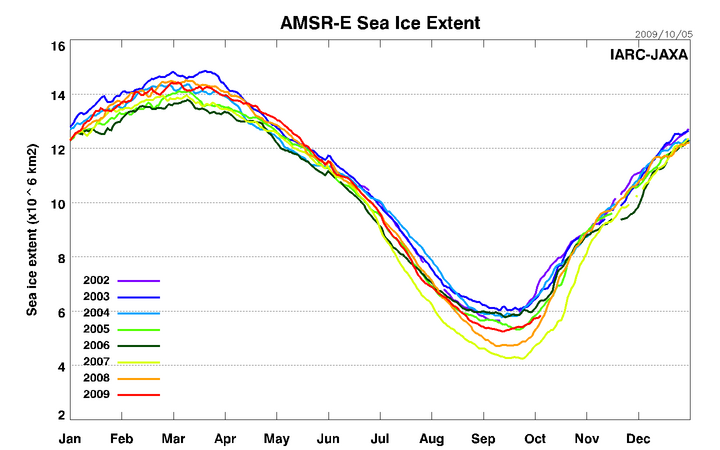UN Climate Reprt Confuses Artic and Antarctic
From Alex Jones's Prison Planet:
Harold Ambler
Talking About The Weather
Wednesday, October 7, 2009
 A misidentified image of Antarctica used by the United Nations Environment Program. (Source: Shutterstock)
A misidentified image of Antarctica used by the United Nations Environment Program. (Source: Shutterstock)Things get stranger and stranger with the United Nations’ world-class, cream-of-the-crop science compendium published two weeks back.
First, it was learned that the alarming graph indicating temperature for the past 1,000 years had been taken from Wikipedia, where it had been deposited by a non-climatologist. Now, it comes to light that the report features a photograph purporting to show Arctic icebergs melting, when the actual image is of Antarctica.
As I looked through the updated report yesterday, in which the Wikipedia graph has been removed, I noticed that an image looked to have been misidentified. Fortunately for me, the UN had purchased the image on Shutterstock.com, where about an hour’s worth of sleuthing revealed that indeed this was not a picture from the top of the world, but rather from the bottom.
Some will say that it doesn’t matter. I think it does. Of course, global warming alarmists, including those employed at the United Nations, have been using both polar ice caps’ melt as evidence of runaway global warming for years now. Meanwhile, though, Antarctic sea ice has continued to increase in extent throughout the satellite era, and temperatures at the South Pole have slowly fallen.
Nonetheless, the fear-mongers in the media and at the United Nations strive to frighten the credulous into believing that Earth’s southernmost continent is on the verge of catastrophic melt. As for the Arctic misrepresented by the UN’s photograph, how many of the report’s editors even know that sea ice increased in 2009 in the Arctic for the second year in a row? At the United Nations Environment Program, the answer is evidently: none. A map with a list of “climate anomalies” from the last year indicates that 2009 was the second most significant melt in the Arctic. In fact, it was the third lowest melt and may very well represent a turnaround. Only time will tell. Even The New York Times has an article today addressing the seeming good news.
As for that list of “Significant Climate Anomalies from 2008/2009,” the great majority of items listed are weather, rather than climate. An example: the four passages of Tropical Storm Fay across Florida’s coastline. While interesting, Fay’s behavior does not have an apparent, or hidden, relationship to rising co2 levels according to any reputable scientist, nor does it cloak 2008’s quiet Atlantic tropical cyclone season. (For those keeping track at home, 2009’s has been quieter still.)
 The recovery from 2007’s record sea extent minimum in the Arctic has continued for a second straight year. Only time will tell whether it marks the beginning of a meaningful, long-term recovery.
The recovery from 2007’s record sea extent minimum in the Arctic has continued for a second straight year. Only time will tell whether it marks the beginning of a meaningful, long-term recovery.Another error in the UN report should give any follower of climatology pause: the Mauna Loa co2 record is shown as “Keeling 2009.” While the graph is rightly referred to by climate professionals as the Keeling Curve, Dr. Keeling has been unable to author any new articles of late, as he passed away in 2005. (Like the other misattributed graph in the report, this one has tell-tale signs that it was simply pulled from Wikipedia.)
The last mistake in the UN report that I will delve into today features a photo of the Hawaiian Islands with a menacing caption about sea levels – trouble in paradise! Here is the text from the caption: “In Hawaii, as the ocean continues to rise, flooding occurs in low-lying regions during rains because storm sewers back up with saltwater and coastal erosion accelerates on beaches. Source: L. Carey.”
There are a few problems here. One: “L. Carey” does not exist, at least not according to the author of the caption. That would be Chip Fletcher, director of the Coastal Geography Group at the University of Hawaii. Reached for comment, Fletcher said that he was flattered that the United Nations report had found his statement in an internal department newsletter to be useful. Two: Fletcher also acknowledged that all of the flooding described by his statement takes place in areas of landfill that are subsiding.
Did Fletcher think that it might be a good thing for the United Nations to note the landfill subsidence when using a single image, and a single statement, to convey the reality of “climate change” in the islands? “Listen, the world is a big place,” Fletcher said. “I have other things to worry about than that.” Were there other locations in the islands that saw such flooding? “Parts of Waikiki have,” Fletcher said. Aren’t those parts of Waikiki also landfill, though? “Actually, they are."

